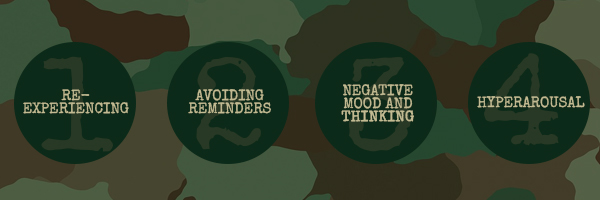Post-traumatic stress disorder (PTSD) is a disorder that some people develop after experiencing a shocking or dangerous event. Nearly everyone who experiences trauma will experience some form of stress reaction in the days after the event, but not everyone develops PTSD. People who experience symptoms that interfere with their life longer than a month may have PTSD. Symptoms of PTSD usually appear within several months of experiencing a traumatic event, but sometimes it takes longer, maybe even years, for symptoms to present themselves.
PTSD is characterized by 4 main types of symptoms.

1. Re-experiencing the event.
Memories of the traumatic event can come back in an intense way at any time, bringing back the same feelings of fear. Some ways a survivor can re-experience an event include:
- Nightmares: Not only are trauma survivors more likely to have nightmares, those who do may have them quite often. Some survivors may have nightmares several times a week. Nightmares that follow trauma often involve the same scary elements that were in the trauma.
- Flashbacks: During a flashback, a person with PTSD may feel as though the traumatic event is happening again. A person may lose all awareness of what is going on around them and feel as though they are completely transported back to their traumatic event, or they may maintain some connection to the present moment.
- Triggers: Words, objects, or situations that remind the individual of the event can trigger re-experiencing symptoms.
2. Avoiding things that remind you of the event.
A person may change his or her personal routine to avoid places, events, or objects that remind them of their traumatic experience. For example, if their military convoy was bombed, the person may avoid driving. They may also avoid talking about their traumatic experience, or try to stay very busy to keep from having any free time to think about the event.
3. Negative changes in thinking and mood.
As a result of the trauma, the way a person with PTSD thinks about themselves and others changes. These changes can include:
- Emotional numbing. People with PTSD may experience difficulties having positive feelings like love and happiness. They could lose interest in activities that were once enjoyable.
- Relationship problems. An inability to show appropriate affection and emotion can negatively impact relationships with loved ones.
- Feelings of mistrust. After a traumatic event, someone with PTSD may lose trust in others and the world in general, believing it to be a dangerous place.
4. Hyperarousal
PTSD sufferers exist in a constant state of being “keyed up”. An excess of nervous energy may result in:
- Difficulty sleeping.
- Trouble concentrating.
- Being easily startled by noises or sudden movements.
- Feeling constantly “on guard”.
- Irritability and angry outbursts.
Source: National Center for PTSD, NIMH
Our facility is conducting a clinical research study for military-related PTSD.
If your or a loved one served in the military and are experiencing symptoms of PTSD, we hope you’ll consider learning more about this clinical trial. If you fill out your information below, a member of our staff will reach out to share more information and see if you qualify.
